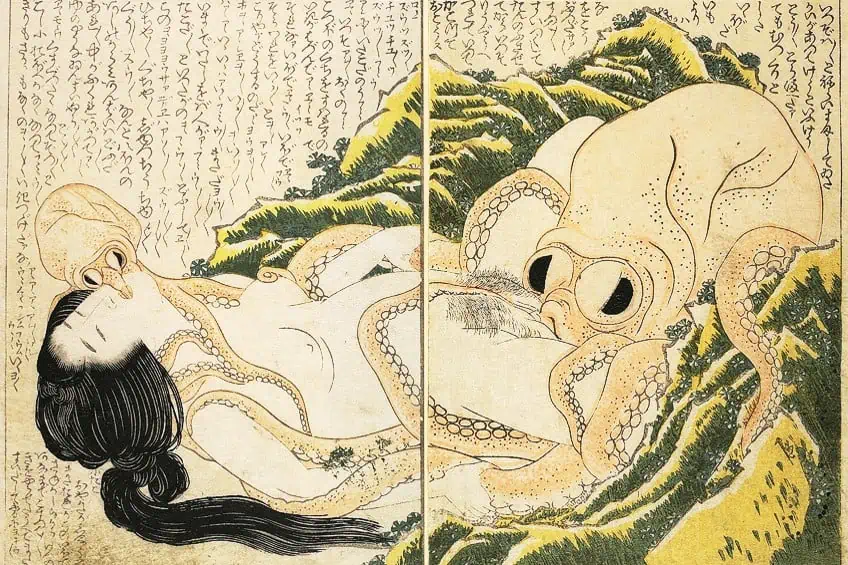Japanese Erotic Art Shunga – Learn All About This Art Form
What is shunga, and why is the art form so significant? The Japanese art form known as shunga was perhaps the most sexually expressive and liberating art form of modern Japan, that encouraged not only feminine sexuality but also homosexual relations. In this article, we will introduce you to the practice of shunga, as well as a few famous shunga artworks and why the art form was so popular in Japan. Keep reading for more about this intriguing art form!
An Introduction to Shunga Art
You may have come across erotic Japanese paintings, which may seem incredibly provocative and raunchy considering the time in which it was produced. These erotic paintings are part of the ancient Japanese erotic art shunga, which has been described by historians as an art form that celebrates the pleasure of sexual desire and attraction. This ancient erotic art form is featured in illustrations and paintings produced using Ukiyo-e and woodblock printing techniques.
The term “shunga” translates in English to an “image of spring”, of which the season spring was often used as a euphemism for sex.
The art form developed alongside Ukiyo-e artworks and was widely distributed by people in the Edo era. The military dictators of Japan who were appointed by the Emperor, known as the shogunate, did not entirely approve of the art form, however, its reception by the public popularized the art form and recognition across Edo society.

As part of the Ukiyo-e movement, the art form aimed to idealize everyday life and gain favor among the chōnin social class, who were considered subordinates to the samurai class. Since the term “shunga” itself directly translates to a reference to sex, it is not difficult to spot a shunga painting. However, an interesting point to note about the meaning of the term is that it is also a contradiction of shunkyū-higi-ga, which was a set of 12 Chinese scrolls that illustrated the different sexual acts that the Crown Prince performed to express the energy of yin-yang.
Notable Influences on Japanese Erotic Paintings
Many artists working in Ukiyo-e processes all produced the ancient Japanese erotic art shunga at some point in their careers and were inspired by the styles of illustrations found in Chinese medicinal literature around the Muromachi period (c. 1336 – 1573).
Another largely influential artist was the Chinese painter Zhou Fang, who was famous for his exaggerated representations of genitalia that resembled shunga topos.

Major influences on Japanese shunga were also derived from the Heian era among the courtier class. These illustrations were found on handscrolls and included narrative scenes featuring court scandals and sexual illustrations inspired by events from monasteries or rumors surrounding monks or courtiers.
What Was Shunga Used For?
So, what was this ancient erotic art form used for? Apart from its use as a form of entertainment and visual pleasure, shunga was seen as a superstitious art form for its ability to ward off fire and death. It was also a good luck charm that was owned by various groups of people, who were required to live apart from the opposite sex. These included figures such as samurai and traveling merchants.
The most obvious function for shunga was perhaps the need for sexual stimulation owed to a more primal drive for those who were sexually repressed, thus making it an ancient form of pornography.
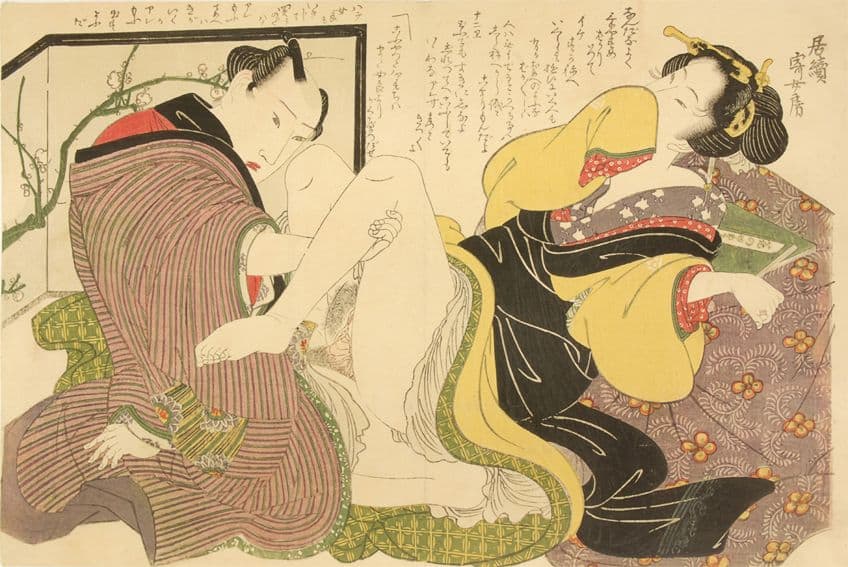
Shunga was also used by women in Edo Japan, despite its focus on masculine pleasure. It is believed that shunga was also used as a gift given to newlywed brides as an educational manual for married life and sexual intercourse. Many people also used shunga for its humorous qualities as an added item for entertainment among friends.
Characteristics of Shunga Art
Now that you have an idea of what shunga is and what it was used for, we will dive into a few visual characteristics of these ancient Japanese erotic paintings. Nudity in Edo Japan was not always viewed as sexual since religious groups such as the Shinto religion viewed sex as natural and without shame. There were also strict laws surrounding adultery in the Edo period, which upheld social frameworks surrounding respect in marriage.
One of the most apparent characteristics of shunga art is its exaggeration of genitalia, which was almost comical and was accompanied by unusual and almost unattainable sexual positions.
The art form was also produced on woodblock prints or ink paintings that were created using handscrolls and materials that enabled mass production and reproduction. Most shunga artworks portrayed scenes with heterosexual couples but also included works with same-sex partners. Another form of exaggeration in shunga art was the presence of expressive facial expressions that conveyed joy, pleasure, and satisfaction.
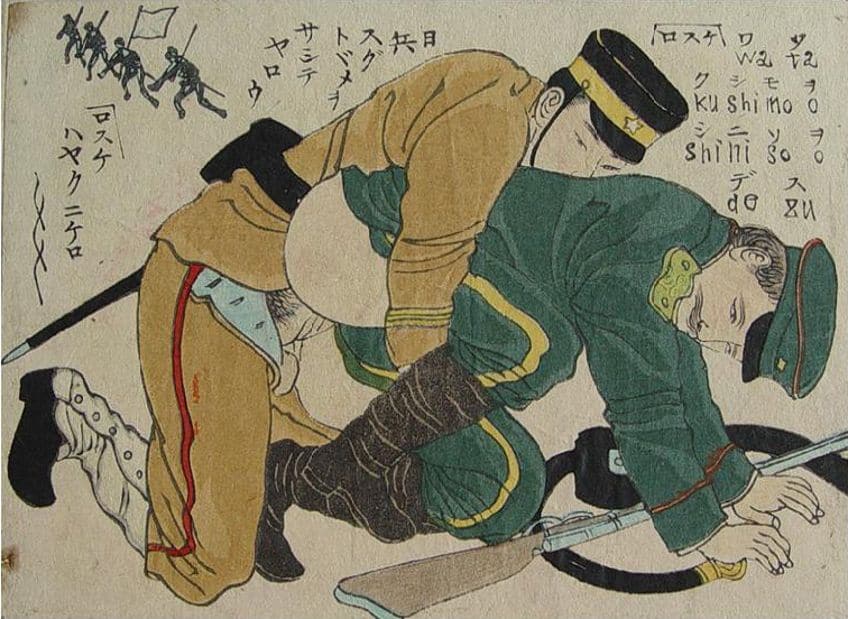
Erotic art was not solely restricted to Japan and was also found in China, where artists illustrated genitalia differently, with more accurate proportions. From complex sexual positions to elaborately decorated scenes with couples wearing exquisite garments, these erotic Japanese paintings explored many aspects of sex in the Edo period.
Famous Shunga Artworks
From artists like Katsushika Hokusai to Kitagawa Utamaro, shunga was an art form most artists strived to perfect. Below, we have compiled a selection of the best shunga artworks from Japanese art history that will offer visual insight into the styles and visual characteristics of shunga.
Lovers Surprised (c. 1660s) by the Kanbun Master
| Artist Name | The Kanbun Master (1660 – 1673) |
| Date | c. 1660s |
| Medium | Ink and color on hanging scroll |
| Dimensions (cm) | Unavailable |
| Where It Is Housed | Honolulu Museum of Art, Honolulu, Hawaiʻi |
Recognized in English as Caught in the Act, this famous Japanese shunga painting was created by a renowned woodblock printer called the Kanbun master around the 1660s. The artwork is known as one of the lesser visually explicit shunga artworks but is iconic in its representation of a couple who appears to be caught sharing a moment of intimacy.
A scene that is immediately relatable to many, it is also a timeless piece and incredibly contemporary for a work of art in the 17th century.
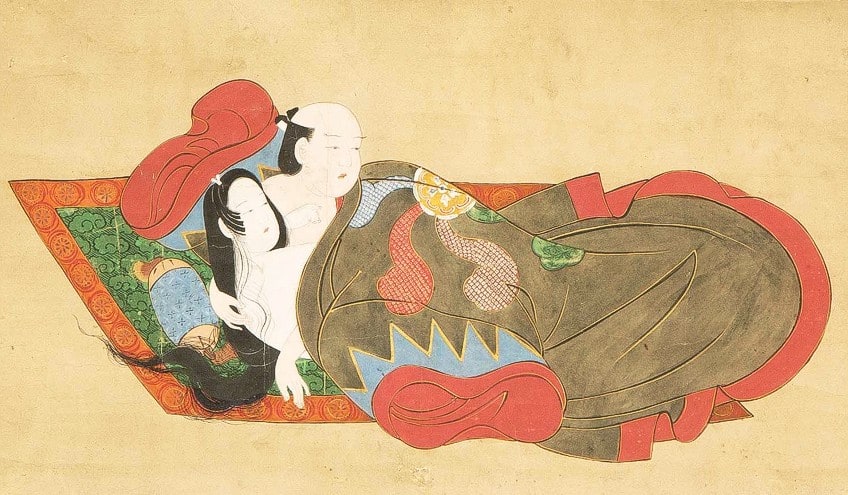
One can also admire the splendid detail and care taken to represent the young woman’s hair, which appears unsettled, and ruffled, and is an indication of her vulnerable state as she lifts her head in surprise and fear of being discovered with her lover. Her partner protectively holds her as they shield themselves with a large garment.
Twelve Shunga Prints (1799 – 1802) by Kitagawa Utamaro
| Artist Name | Kitagawa Utamaro (c. 1753 – 1806) |
| Date | 1799 – 1802 |
| Medium | Woodblock prints |
| Dimensions (cm) | 36.2 x 24.9 (per image) |
| Where It Is Housed | Private collection |
This fascinating and colorful collection of shunga prints was created by renowned Japanese shunga artist Kitagawa Utamaro between 1799 and 1802. The collection was compiled from the artist’s two famous publications, Unravelling the Threads of Desire (1799) and Picture Book: Pulling Komachi (1802), which demonstrate a wide variety of sexual positions painted in the horizontal format and depicting primarily heterosexual couples.
The collection displays a uniform set of colors with the figures adorned in different garments engaging in the act in indoor environments.
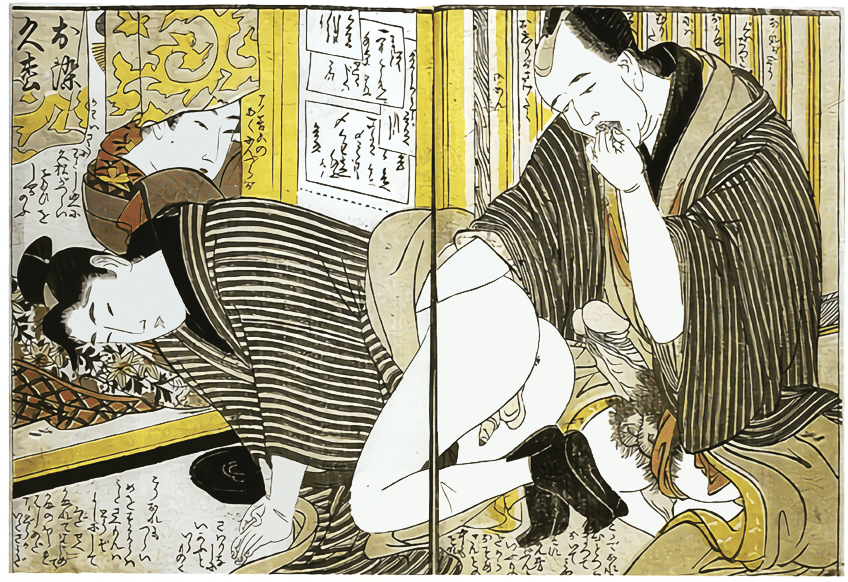
Lesbian Couple With Harigata (c. 1801) by Chokyosai Eiri
| Artist Name | Chokyosai Eiri (1789 – 1801) |
| Date | c. 1801 |
| Medium | Ink and color |
| Dimensions (cm) | Unavailable |
| Where It Is Housed | Unavailable |
This unique shunga print was created by Edo shunga artist Chokyosai Eiri in the early 19th century and was best known for her paintings and illustrations of women. Lesbian Couple With Harigata is a famous shunga work that reflects Eiri’s style, which was influenced by figures like Utamaro. What makes this artist so fascinating is his debated identity, which had scholars arguing over his true identity and possible identities such as Shikyusa, Chokyosai, Reikisentei, Eiri Hosoda, or all three.
The print itself also represents two female lovers who use a sex toy to pleasure each other. The toy was known as a harigata, and its appearance in the print was said to be unusual considering it was part of a series called Fumi no kiyogaki.
The woman wearing the harigata also appears to apply an aphrodisiac cream as a lubricant to enhance their pleasure. What makes the work so amazing is it is an example of lesbian pleasure expressed in a samurai mansion, which also highlights a unique space without men and the affection that women grew for each other among the ladies-in-waiting class.
Dream of the Fisherman’s Wife (1814) by Katsushika Hokusai
| Artist Name | Katsushika Hokusai (1760 – 1849) |
| Date | 1814 |
| Medium | Woodblock print |
| Dimensions (cm) | 19 x 27 |
| Where It Is Housed | The Metropolitan Museum of Art, New York City, and the Art Institute of Chicago, Illinois, United States |
Dream of the Fisherman’s Wife is one of the most famous examples of shunga art from the 19th century. The renowned woodblock print was created by none other than Japanese master artist Katsushika Hokusai in 1814 and has since been acquired by major institutions such as the Art Institute of Chicago and the Metropolitan Museum of Art.
This famous erotic print portrays a female diver, who is receiving sexual pleasure from two octopuses.
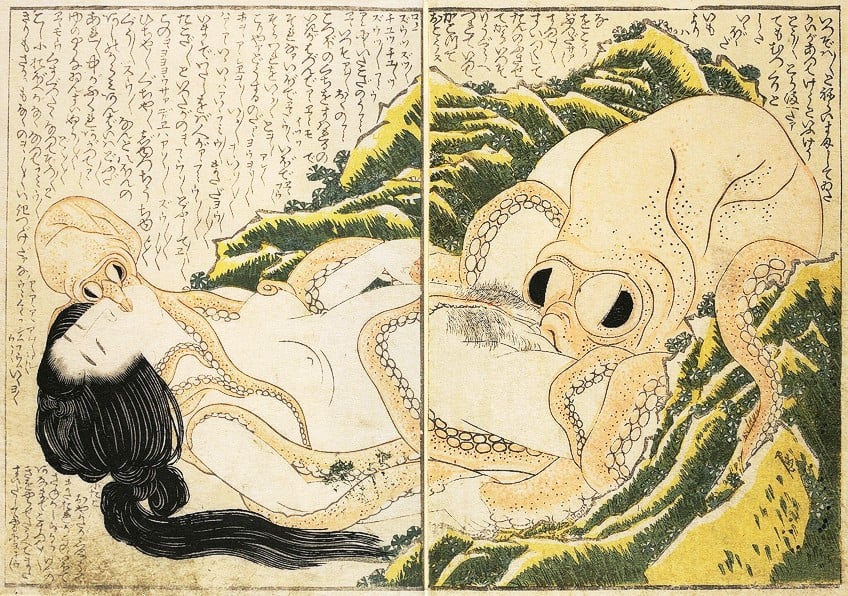
The inspiration for this dramatic and fantastical composition is said to be derived from the tale of Princess Tamatori, who was a diver who obtained a valuable pearl from the undersea palace of a water dragon. Since its creation, the shocking image has left a resounding impact on erotic art throughout the Edo period and beyond. The print recently sold for $2.8 million in 2023.
The Impact of Shunga on Western Art
As the Edo period passed, certain regulations were passed to ban certain elements from Modern Japan. This included erotic images and shunga, which were then called warai-e, or “laughing pictures”. In the modern period, society turned to open eroticism and began to view shunga as obscene and taboo. However, the impact of the art form on Western art took shape in a genre called erotic Japonism associated with romantic orientalism in mid-19th century Europe.
The art styles of Japanese shunga prints also influenced artists such as Pablo Picasso, Gustav Klimt, and Auguste Rodin, who took an interest in the revealing art form that expressed incredibly modern aspects of life.
This influence was double-sided and also seen in Japanese art from the mid-19th century when the term wakon yosai emerged to describe the influence of European art on Japanese styles. During the Meiji restoration in 1868, many artists adopted the themes and methods of European artists. Long before this, figures like Francis Xavier introduced Christian art to Japan around 1549 to decorate new altars.
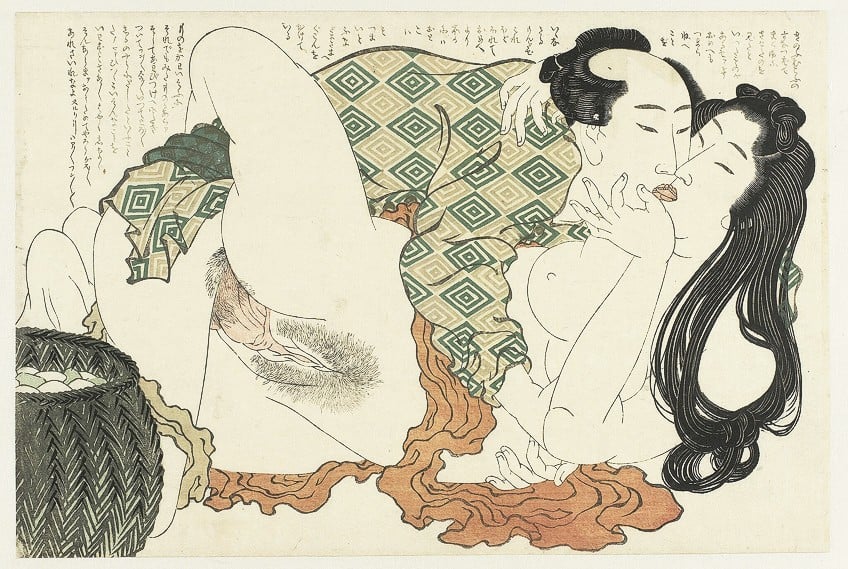
A representative of the Jesuits called Alessandro Valignano also influenced the development of Japanese art after he established a cultural center aimed at teaching people about the Christian religion alongside music, painting, language, and etching. European and Western art was not always welcomed in Japan, especially after the release of the Sakoku Edicts around 1630, which restricted foreign access to Japan. The Japanese erotic art shunga, however, has been preserved by a select few artists and continues among groups of Contemporary artists today such as Jeff Faerber and Senju Horimatsu.
These famous shunga artworks and their creators showcased the different forms of sexual expression in the Edo period, which provided interesting and unique perspectives into how erotic art was presented to the public. Its widespread acceptance in Edo society is also an example of how past societies were perhaps more open to sexual expression among same-sex couples and the ways that shunga influenced Western art to embrace new printing styles.
Frequently Asked Questions
What Is Shunga Art?
Shunga is recognized as a traditional erotic art form that originated in Japan and predated the development of Ukiyo-e art. This erotic art form encapsulated depictions of sexuality, everyday life, and expressive sexual engagements between heterosexual and queer individuals from all classes in Edo society.
What Type of Art Is Shunga?
Shunga is an erotic art form created in the style of hanging scrolls and ink paintings. Shunga art demonstrates the exaggerated, humorous, idealized, and sexually explicit aspects of Edo society, which served as a form of entertainment, pleasure, sex education, and erotic stimulation.
Which Famous Japanese Artists Created Shunga?
Two of Japan’s most famous painters and printers created shunga art. These include Kitagawa Utamaro and Katsushika Hokusai, who created some of the most unique and recognizable shunga artworks.
Jordan Anthony is a Cape Town-based film photographer, curator, and arts writer. She holds a Bachelor of Art in Fine Arts from the University of the Witwatersrand, Johannesburg, where she explored themes like healing, identity, dreams, and intuitive creation in her Contemporary art practice. Jordan has collaborated with various local art institutions, including the KZNSA Gallery in Durban, the Turbine Art Fair, and the Wits Art Museum. Her photography focuses on abstract color manipulations, portraiture, candid shots, and urban landscapes. She’s intrigued by philosophy, memory, and esotericism, drawing inspiration from Surrealism, Fluxus, and ancient civilizations, as well as childhood influences and found objects. Jordan is working for artfilemagazine since 2022 and writes blog posts about art history and photography.
Learn more about Jordan Anthony and about us.
Cite this Article
Jordan, Anthony, “Japanese Erotic Art Shunga – Learn All About This Art Form.” artfilemagazine – Your Online Art Source. October 24, 2023. URL: https://artfilemagazine.com/japanese-erotic-art-shunga/
Anthony, J. (2023, 24 October). Japanese Erotic Art Shunga – Learn All About This Art Form. artfilemagazine – Your Online Art Source. https://artfilemagazine.com/japanese-erotic-art-shunga/
Anthony, Jordan. “Japanese Erotic Art Shunga – Learn All About This Art Form.” artfilemagazine – Your Online Art Source, October 24, 2023. https://artfilemagazine.com/japanese-erotic-art-shunga/.


